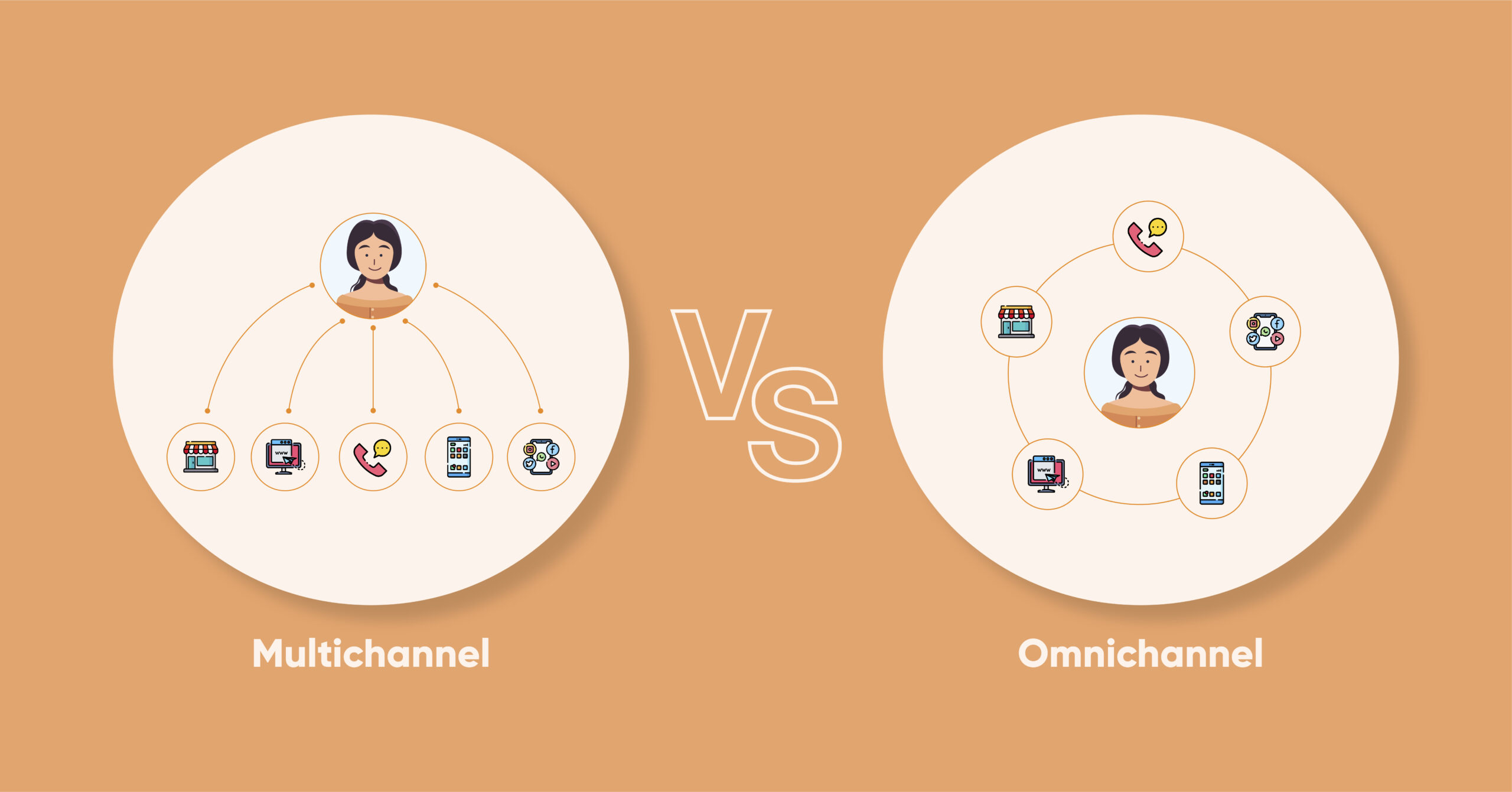In today’s competitive world, brands are going beyond traditional marketing to create personalized experiences that meet customers’ needs wherever they are. But when we hear terms like “omnichannel multichannel,” what do they really mean, and why do they matter? Let’s dive into these two popular marketing approaches to understand how each serves the goal of connecting with customers—and which one might be best for your business.
Omnichannel Multichannel: Choosing the Right Strategy for Your Business

Defining Omnichannel
What is Omnichannel?
Omnichannel refers to a strategy where a brand provides a cohesive and integrated customer experience across all its channels. Whether a customer interacts with the brand via social media, in-store, online, or through a mobile app, each interaction is connected and part of a seamless journey. Omnichannel marketing recognizes that customers move fluidly between channels and prioritizes creating a smooth, integrated experience.
Examples of Omnichannel Strategies
Consider a customer who browses products on a brand’s website, adds items to their cart, and then heads to the store where those same items are waiting for them to try out in person. The use of an app that connects the website, store, and even email follow-ups is a hallmark of omnichannel marketing.
Defining Multichannel
What is Multichannel?
In a multichannel approach, brands reach customers through multiple, separate channels such as email, social media, or in-store. However, unlike omnichannel, each channel operates independently and doesn’t necessarily integrate with others. The customer experience may vary between each channel, and the brand is more focused on maintaining a presence across multiple touchpoints.
Examples of Multichannel Strategies
A retailer using a multichannel approach might interact with customers via Instagram, email newsletters, and physical stores, but the experiences in each are distinct. A social media campaign might promote new products, while in-store promotions are handled separately, with no cross-channel connection.
Key Differences Between Omnichannel and Multichannel
Central Focus on Customer Experience
The main difference between omnichannel and multichannel lies in the focus: omnichannel is centered on creating a consistent customer experience, while multichannel focuses on broadening reach through separate channels.
Integration vs. Segmentation of Channels
Omnichannel requires channels to be integrated, where each touchpoint is interconnected. Multichannel, on the other hand, views each channel as its entity, catering to diverse customer preferences without necessarily connecting them.
How Omnichannel Works
Creating a Seamless Customer Journey
In an omnichannel strategy, every interaction builds upon the previous one. For instance, a customer might start a shopping cart online and later receive a reminder email, followed by in-store availability. Each step complements the others, creating a cohesive journey.
Technology and Integration Needs for Omnichannel
Effective omnichannel marketing often relies on customer relationship management (CRM) systems, data analytics, and integration tools. These technologies help track customer interactions and ensure consistent communication across channels.
How Multichannel Works
Managing Multiple Channels Individually
In a multichannel setup, each channel operates independently. A customer’s online behavior may not impact their in-store experience, and vice versa. The brand manages each touchpoint separately, focusing on its own metrics and goals for each.
Technology Used in Multichannel Strategies
While CRM systems may be used in multichannel strategies, the focus is usually on managing separate tools for each channel, like social media management platforms, email marketing software, and physical store systems.
Advantages of Omnichannel Marketing
Consistent Customer Experience
Omnichannel marketing enables brands to offer a seamless experience, ensuring customers don’t feel disconnected regardless of the platform they choose.
Increased Customer Engagement and Loyalty
By providing a consistent journey, omnichannel marketing builds loyalty, encouraging customers to return due to the ease and convenience of the experience.
Improved Data Collection and Insights
Since every channel is connected, brands can gain insights into customer behavior across touchpoints, leading to more effective personalization and better decision-making.
Advantages of Multichannel Marketing
- Flexibility in Channel Management
Multichannel marketing allows brands to tailor content specifically for each channel, creating flexibility to cater to different customer segments.
- Broad Reach to Diverse Customer Segments
By managing each channel independently, brands can adjust their strategies to suit the specific demographics of each platform, maximizing reach.
- Easier Execution for Smaller Businesses
Multichannel strategies often require less complex technology and are more accessible to smaller businesses with limited resources.
Challenges of Omnichannel Marketing
Complexity in Implementation
An omnichannel strategy requires significant investment in technology and resources, as well as careful planning to ensure a seamless experience.
Higher Costs and Resource Requirements
Maintaining consistent integration and communication across channels demands a larger budget, making it challenging for smaller brands.
Challenges of Multichannel Marketing
Potential for Inconsistent Customer Experience
Since each channel is managed separately, customers may experience inconsistencies when moving from one channel to another.
Difficulty in Integrating Data Across Channels
Without a unified approach, it’s harder to track customer journeys and gain insights into cross-channel behavior, limiting personalization.
How to Transition from Multichannel to Omnichannel
Start by evaluating existing channels and understanding where customers are dropping off or facing inconsistencies.
Gradually integrate technology that connects channels, like CRM and data management systems, to facilitate seamless interactions across touchpoints.
Technological Requirements
- CRM and Data Integration Tools: A strong CRM system is essential for gathering data and tracking customer interactions across channels, helping brands build a unified experience.
- Importance of AI in Omnichannel Strategies: AI enhances personalization by analyzing customer behavior and preferences, offering tailored recommendations and interactions.
Industry Examples
Retailers like Target use omnichannel strategies to connect their in-store and online experiences, offering features like “Order Pickup” and “Drive Up.”
Banks often use multichannel approaches, but many are evolving to omnichannel strategies, providing a consistent experience whether online or in a branch.
Healthcare providers use omnichannel strategies to streamline appointment booking and follow-up, creating a more convenient experience for patients.
Future Trends
- Trends in Digital Transformation
As technology advances, more brands are expected to adopt omnichannel approaches to enhance customer satisfaction.
- The Role of AI and Automation
AI and automation will play a significant role in omnichannel success, helping brands deliver more personalized and seamless experiences.
Case Study: Elevating Customer Experience Through Omnichannel Transformation
A leading retail company in the home goods sector was facing challenges with the increase in usage of digital platforms. As their customers were interacting with them through different channels, including physical stores, an online website, social media, and a mobile app. Having all these channels was challenging to remain consistent with all of them. As many customers were complaining about the inconsistent shopping experiences. They could shop online, but often find discrepancies in pricing or availability when visiting stores. Also, the marketing strategies were disconnected from one channel to another. This leads to difficulty in tracking the customer’s journey and personalizing the communication messages.
Challenge
The company realized that it needed to transform from a multichannel approach to an omnichannel approach. To be able to stay competitive in the market and enhance their customers’ loyalty. So they were facing some challenges in this process.
- Creating a seamless journey for the customers across all the channels.
- Integrating the online and offline channels and the data on them.
- Providing constant personalized messages to the customers all the time.
- Investing in useful technology to help with a better workflow.
Solution
The company started the process of omnichannel transformation in some key steps.
- Technology Integration: started by implementing a centralized Customer Relationship Management (CRM) system. Which was able to collect and synchronize all the customer data and feedback from the different sources. This helps in creating a database for all the customers from the website, app, social media, and physical stores.
- Unified Inventory and Fulfillment: Developed a real-time inventory tracking system across all the available channels. To help customers see the product online and reserve the items at pick-up points.
- Personalized Marketing: The company was able to leverage AI-driven analytics. To be able to craft email campaigns and app notifications based on customers’ purchasing history. To ensure providing relevant offers are provided to the customers and sending reminders.
- Consistent Experience: Accessing the customer’s profile in store by the staff to provide suitable assistance. In addition to offering personalized recommendations based on their preferences.
Results
- Increased Customer Engagement: The integration of the omnichannel led to a 30% increase in customer usage across multiple channels during their shopping experience.
- Higher Conversion Rates: The process of reserving the products online for in-store pickup leads to an increase in conversion rates by 20%.
- Improved Customer Loyalty: The repeat purchase by customers increased by 15%. As a result of the personalized marketing and consistent experience.
- Enhanced Data Insights: The CRM system provided comprehensive insights and analytics. Which leads to refining the marketing campaigns and products, and offering more effectively.
Key Takeaways
The case study showed the benefit of integrating the omnichannel instead of the multichannel. Which led to improvement in different aspects, including customer experience and sales. Also, it helped the company to gain a competitive edge in this crowded industry.
Conclusion
Both omnichannel and multichannel approaches have unique strengths that cater to different business needs. While multichannel allows brands to reach broader audiences through separate channels, omnichannel focuses on providing a connected, consistent customer journey that enhances loyalty and satisfaction. Choosing the right approach depends on your business goals, resources, and, ultimately, your customers’ expectations for a seamless experience.
Ready to enhance your brand’s customer experience? Discover how AIM Technologies can support your journey to creating a connected customer experience with an omnichannel approach. Request a demo today to see how our solutions can help your brand engage, analyze, and connect like never before.
FAQs
- What are the key differences between omnichannel and multichannel?
Omnichannel integrates all channels for a seamless experience, while multichannel operates each channel separately. - Which is better: omnichannel or multichannel?
It depends on your goals; omnichannel enhances consistency, while multichannel is easier for broader reach. - How can small businesses implement omnichannel?
Start small, integrating channels gradually with CRM systems and data analytics to unify customer interactions. - What role does technology play in omnichannel success?
Technology like CRM and AI is essential in creating connected experiences by tracking and personalizing interactions. - Is multichannel marketing outdated?
Not necessarily. Multichannel remains valuable for broader reach, but more brands are moving toward omnichannel for better consistency.




